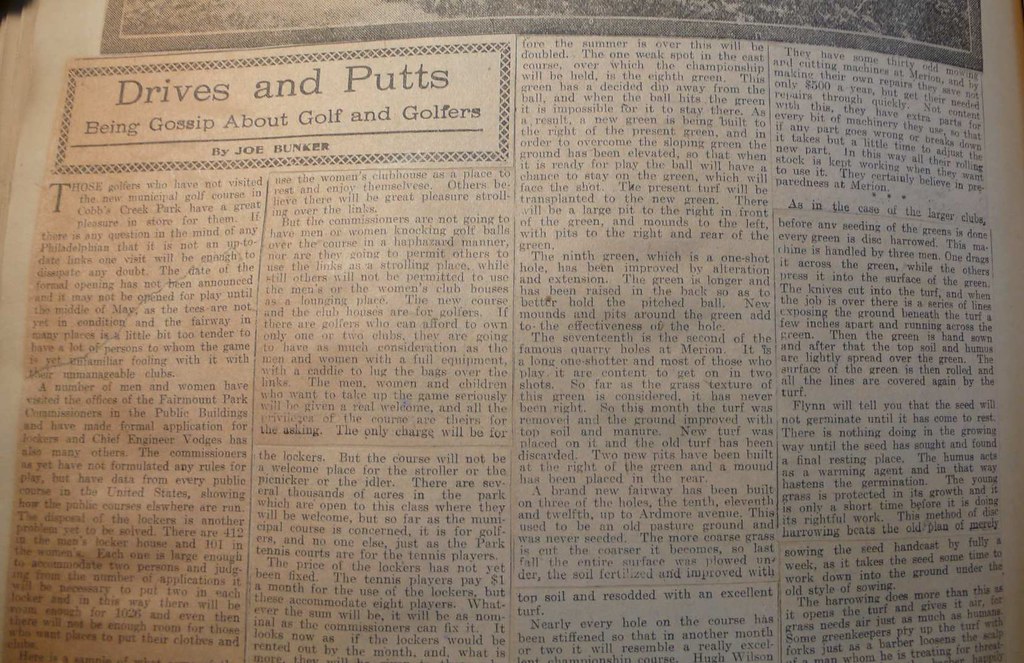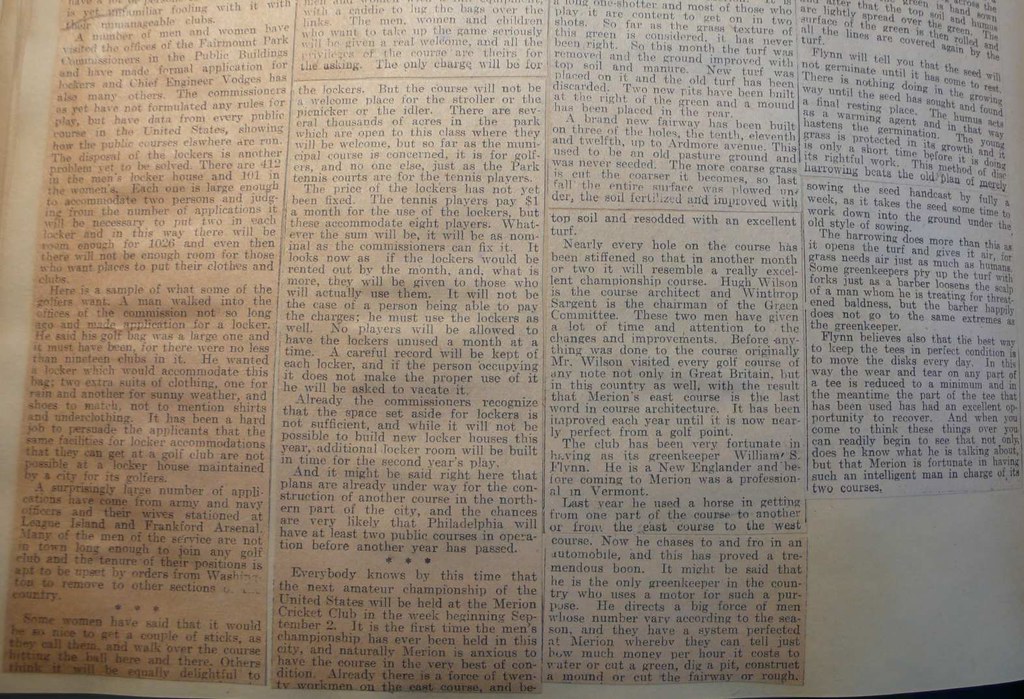In an attempt to wrap this thread up based on what we know to date;
May/June 1913 - Course building starts - Articles indicate that former Atlantic City pro William Robinson has been put in charge of the project and he is soliciting expert opinions on the layout. An August article indicates that the course has been laid out by experts who have prior experience. The Evans article in October 1913 indicates Hugh Wilson was Geist's right hand man and laid out the course. Later articles reiterate that attribution.
January 1914 - A hurricane eliminates four low-lying holes near the bay and forces that purchase of additional land and the subsequent creation of four new holes.
Summer 1914 - Course open to membership play
December 1914 - Hugh Wilson resigns as chairman of the Merion Green Committee citing the need to devote more time to his business. He has just designed and built Merion East, Merion West, and probably Seaview as a hobby over the previous 3 years, and become heavily involved with significant redesigns at North Hills and Philmont.
January 1915 - Official Grand Opening Tournament with celebrities Chick Evans and Jerry Travers in a four-ball and AW Tillinghast serving as referee. William Connellan is mentioned as being the superintendent.
April 1915 - Club hires Wilfred Reid as pro.
April 1915 - Francis Ouimet partners with Hugh Wilson to defeat Clarence Geist and Wilfred Reid in a publicized match and also sets the new club record of 73
May 1915 - Club hires Donald Ross to "stiffen" the course by adding bunkers. American Golfer reports that
"Seaview has called in Donald Ross
to build traps, and his ideas, together
with those of Wilfrid Reid, should
stiffen the Absecon course considerably."
After designing and building what was intended and anticipated to be Philadelphia's first post-guttie "Championship Course" with Merion East, Hugh Wilson probably never intended to do anything further but go back to playing golf at his club and attending to his business and expanding family.
By September 1912, his daughter Louise would have been approaching her 6th birthday, and his daughter Nancy would have just been turning 2.
Once Merion East opened, so did the floodgates. Within a few short months, popularity of golf at the club exploded and the club had to restrict memberships to combat the huge demand for play. Hugh Wilson was called back into service by club officials to build them another course, which was ready to be seeded by Fall 1913.
Merion Cricket Club minutes from the fall of 1913 reportedly had the following entry;
"With the opening of the then new East Course in September of 1912, the number of players at Merion increased so largely as to make the facilities afforded –
which it was expected would be sufficient for all time to come - so insufficient for the enjoyment and pleasure of the members that complaints were made with such seriousness as to require attention from your Board..."
"Merion now becomes the only golf club in America to possess two full eighteen-hole championship courses...When it (the West Course) is opened in the spring with the bus facilities that will connect it up to the East Course, it is fully expected that the golf members of Merion will have all the facilities that they could possibly desire...
Our position in golf in this country will be second to none and unique in golf history, enabling us to hold tournaments, national, state or city upon our course without interference with the game of our own members."
The Merion West course opened May 1914.
Also please note that this timing was concurrent with Wilson’s activities at Seaview.
We also know from the Piper/Oakley letters that Seaview was hardly a "paper job" and that Wilson was involved in helping to solve unique and probably frustrating, time-consuming construction problems.
What's more, and probably to the chagrin of Hugh Wilson at that time, a SECOND COURSE is already in Geist's plans!
The Seaview course was also originally supposed to open in early 1914, around the same time as Merion West. In fact, in December 1913 Tillinghast reported;
"The new Sea View course,at Absecon is coming on beautifully. The fall seeding has been blessed with fortunate weather condition and greens and fairways already are beautifully green. Here is another course that I must inspect carefully before attempting a critical review.”
However, exactly one year later, due to the January 1914 hurricane and the autumn illness of Clarence Geist, Tilinghast again reported;
"The new course at Sea View Club is coming along beautifully and Mr. C.H. Geist announces that there will be a formal opening sometime soon after the holidays and without doubt the occasion will be a memorable one. Mr. Geist was seriously indisposed for nearly five weeks but as soon as his physician permitted him to leave the house he went immediately to the club and began preparations for this opening."
We also know for certain that Hugh Wilson had other things going on by 1913/14. Specifically, he had been asked by Ellis Gimbel to work on revamping Philmont with greens chairman Henry Strouse. He was on a committee appointed by Robert Lesley, Ellis Gimbel, and Clarence Geist (and two others) to locate appropriate sites for Philadelphia's first and long anticipated public course. He was also working with Ab Smith and J.Franklin Meehan on the new 18 hole course for North Hills.
But, Hugh Wilson and his friends had not only located the site for the Cobb's Creek course at that time, but had already designed it in 1914, prior to the approval by the city of Philadelphia
This January 1915 article already describes the course that had already been designed. That is the same month the project got approval from the city.

This was confirmed in another January 1915 article which states;
"Robert W. Lesley, president, stated on behalf of the Committee on the Park Golf Course, that
he had seen plans for an eighteen hole public golf course prepared as the result of many consultations with himself and other golf experts laid out at the northwestern end of Cobb's Creek Park..." He added further that he is assured that work on the preparation of the course will be begun as soon as the weather permits in the spring. The new links will be of championship length and character and will give Philadelphia a public course second to none in the United States."
Construction began at Cobb’s Creek in April 1915, not coincidentally the same timeline as Ross being called into add bunkers to Seaview. Having been part of the team that selected the site, and the committee who drew up the architectural plans, Wilson evidently took the job close to his home very seriously and was apparently onsite for what appears to be inception to grow-in that fall.

The genesis of this thread was an article from July 1915 stating that Merion had very little in the way of bunkering as of that date, but that the course could be toughened quickly if Merion was selected for a US Amateur tournament. Despite his ongoing work in that regard, Wilson saw the Cobb’s Creek project through to the end, as seen in this article from May 1916, before opening day.

With the announcement of the US Amateur coming to Merion in the fall of 1916, the following articles detail some of the changes Wilson made to the course, likely working closely with William Flynn.




Sadly, about halfway between the triumphs of the opening of Cobb’s Creek in late May 1916, and the unveiling of the new revamped Merion in the September of that year, Wilson suffers a personal tragedy with the death of his six-year old youngest daughter Nancy.
After what had to be a difficult winter for Wilson, the United States entered World War I and golf course design and construction came to a necessary halt.
Finally, Some speculation on why Ross's suggested changes at Seaview were largely never accomplished... (as detailed on this thread from last year;
http://golfclubatlas.com/forum/index.php/topic,38042.0/Ross was brought in April/May 1915, shortly after Geist hired both Wilfred Reid as professional and Wiliam Connellan as superintendent. Tillinghast speculated that the combination of Ross and Reid's ideas would be used to "stiffen" the course, as many in PHiladelphia were all about making tough golf courses at that time (although that was never the original intent at Seaview).
Geist had already spent way over budget on this project, which was to originally open in 1914, but due to problems with fill in the swampy areas, as well as a hurricane, as well as Geist's illness, was officially delayed until winter 1915. Even a man with his deep pockets had some limitations.
I think Hugh Wilson probably believed he could do this for Robert Lesley's friend Clarence Geist in his spare time, but when the project was already running two years, with Geist's originally announced grandiose plans now including a second eighteen holes, I think he gladly backed away from any further involvement, especially since Geist seemed to have hired quality "professional help" in the form of Ross, Reid, and Connellan.
Ross's plans were certainly intriguing and some of the suggestions would have created some bolder holes, but it would be interesting to understand what happened that first year.
Here's what we do know...
By October of 1915, William Connellan resigned.
By 1916, Wilfred Reid had left Seaview and moved to Wilmington CC in Delaware, where he would stay until the early 20s.
And as noted above, some of the most pressing things on Ross's list (like a new, probably safer green for 16) were probably actually done at this time.
However, we also know that probably 80% of what Ross suggested was never done.
By 1916, the world was on fire and it wasn't long before the United States became embroiled in WWI, which brought all frivolous expenditures in the US to a halt.
It's interesting to note that there is very little reported on Geist or Seaview til the middle 20s when a prominent women's tournament took place there. He then became heavily involved with William Flynn building his Boca Raton courses, and it seems Seaview never really was "toughened", or "stiffened" as originally desired.
Today, it seems to be much as it was built for originally; a very pleasant place to play golf requiring intesting and thoughtful shot-placement.
Given that someone probably found the Ross drawings at Seaview, and the fact that just looking at them without much study they do seem to appear much as today's holes, is probably what generated the idea that Seaview was originally a Donald Ross course.
However, I can't imagine that others haven't looked at them over the years seeing notations such as "Present Sand Pit" and not have wondered who built the course originally.
Still, I’m hopeful that some of our research this past year or so has provided much more information about the origins of this historically significant course.
Thanks for your time and feedback.